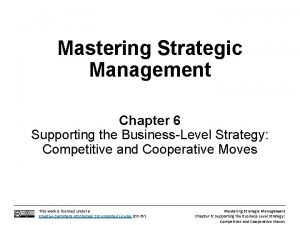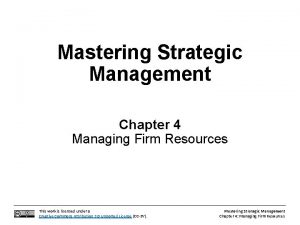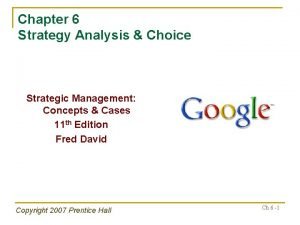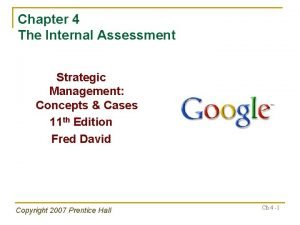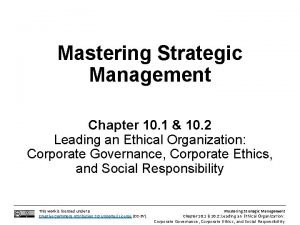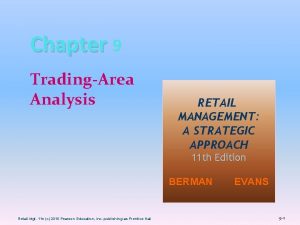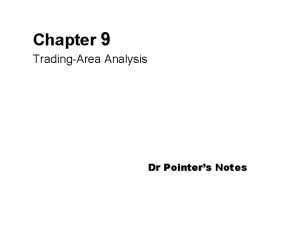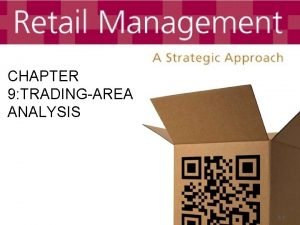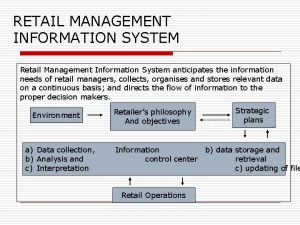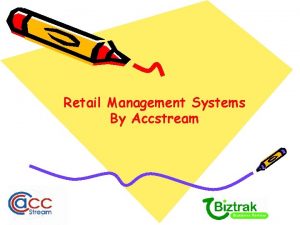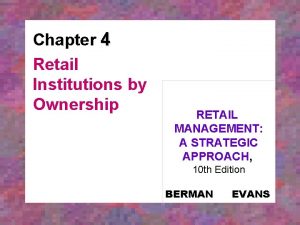Chapter 9 TradingArea Analysis RETAIL MANAGEMENT A STRATEGIC





































- Slides: 37

Chapter 9 Trading-Area Analysis RETAIL MANAGEMENT: A STRATEGIC APPROACH, 9 th Edition BERMAN EVANS

Chapter Objectives ¯ To demonstrate the importance of store location for a retailer and outline the process for choosing a store location ¯ To discuss the concept of a trading area and its related components ¯ To show trading areas may be delineated for existing and new stores 9 -2

Chapter Objectives_2 ¯ To examine three major factors in trading -area analysis ¯Population characteristics ¯Economic base characteristics ¯Competition and level of saturation 9 -3

Location, Location ¯ Criteria to consider include ¯population size and traits ¯competition ¯transportation access ¯parking availability ¯nature of nearby stores ¯property costs ¯length of agreement ¯legal restrictions 9 -4

Figure 9. 1 Importance of Location to Esprit 9 -5

Choosing a Store Location Step 1: Evaluate alternate geographic (trading) areas in terms of residents and existing retailers Step 2: Determine whether to locate as an isolated store or in a planned shopping center Step 3: Select the location type Step 4: Analyze alternate sites contained in the specific retail location type 9 -6

Trading-Area Analysis A trading area is a geographic area containing the customers of a particular firm or group of firms for specific goods or services 9 -7

Benefits of Trading Area Analysis ¯ Discovery of consumer demographics and socioeconomic characteristics ¯ Opportunity to determine focus of promotional activities ¯ Opportunity to view media coverage patterns 9 -8 ¯ Assessment of effects of trading area overlap ¯ Ascertain whether chain’s competitors will open nearby ¯ Discovery of ideal number of outlets, geographic weaknesses ¯ Review of other issues, such as transportation

Figure 9. 2 The Trading Areas of Current and Proposed Outlets 9 -9

GIS Software v Geographic Information Systems – digitized mapping with key locational data to graphically depict trading-area characteristics such as • population demographics • data on customer purchases • listings of current, proposed, and competitor locations 9 -10

Figure 9. 3 a The TIGER Map Service 9 -11

Figure 9. 3 b The TIGER Map Service 9 -12

Figure 9. 4 GIS Software in Action - A 9 -13

Figure 9. 4 GIS Software in Action - B 9 -14

Private Firms Offering Mapping Software Claritas ESRI GDT Geo. Vue Mapinfo SRC 9 -15

Figure 9. 5 The Segments of a Trading Area 9 -16

Figure 9. 6 Delineating Trading -Area Segments 9 -17

The Size and Shape of Trading Areas ¯ Primary trading area - 50 -80% of a store’s customers ¯ Secondary trading area - 15 -25% of a store’s customers ¯ Fringe trading area - all remaining customers 9 -18

Destinations versus Parasites • Destination stores • Parasite stores do not have a better create their own traffic assortment, better and have no real promotion, and/or trading area of their better image own • It generates a trading • These stores depend area much larger than on people who are that of its competitors drawn to area for other reasons • Dunkin’ Donuts: “It’s worth the trip!” 9 -19

Trading Areas and Store Type Largest Department stores Supermarkets TRADING AREAS Apparel stores Gift stores Smallest 9 -20 Convenience stores

Figure 9. 7 Carrefour Shanghai 9 -21

The Trading Area of a New Store Different tools must be used when an area must be evaluated in terms of opportunities rather than current patronage and traffic patterns – Trend analysis – Consumer surveys – Computerized trading area analysis models 9 -22

Computerized Trading-Area Analysis Models Analog Model Regression Model Gravity Model 9 -23

Reilly’s Law Reilly’s law of retail gravitation, a traditional means of trading-area delineation, establishes a point of indifference between two cities or communities, so the trading area of each can be determined 9 -24

Limitations of Reilly’s Law 1. Distance is only measured by major thoroughfares; some people will travel shorter distances along cross streets 2. Travel time does not reflect distance traveled. Many people are more concerned with time traveled than with distance 3. Actual distance may not correspond with perceptions of distance 9 -25

Huff’s Law Huff’s law of shopper attraction delineates trading areas on the basis of product assortment (of the items desired by the consumer) carried at various shopping locations, travel times from the shopper’s home to alternative locations, and the sensitivity of the kind of shopping to travel time. 9 -26

Table 9. 1 Chief Factors to Consider in Evaluating Retail Trading Areas Population Size and Characteristics • Total size and density • Age distribution • Average educational level • Percentage of residents owning homes 9 -27 • Total disposable income • Per capita disposable income • Occupation distribution • Trends

Table 9. 1 Chief Factors to Consider in Evaluating Retail Trading Areas Availability of Labor • Management trainee • Clerical 9 -28

Table 9. 1 Chief Factors to Consider in Evaluating Retail Trading Areas Closeness to Sources of Supply • Delivery costs • Timeliness • Number of manufacturers 9 -29 • Number of wholesalers • Availability of product lines • Reliability of product lines

Table 9. 1 Chief Factors to Consider in Evaluating Retail Trading Areas Economic Base • Dominant industry • Extent of diversification • Growth projections 9 -30 • Freedom from economic and seasonal fluctuations • Availability of credit and financial facilities

Table 9. 1 Chief Factors to Consider in Evaluating Retail Trading Areas Competitive Situation • Number and size of • Short-run and longexisting competition run outlook • Evaluation of • Level of saturation competitor strengths and weaknesses 9 -31

Table 9. 1 Chief Factors to Consider in Evaluating Retail Trading Areas Availability of Store Locations • Number and type of • Zoning restrictions store locations • Costs • Access to transportation • Owning versus leasing opportunities 9 -32

Table 9. 1 Chief Factors to Consider in Evaluating Retail Trading Areas Regulations • Taxes • Licensing • Operations 9 -33 • Minimum wages • Zoning

Figure 9. 8 Analyzing Retail Trading Areas 9 -34

Elements in Trading-Area Selection Population Characteristics Economic Base Characteristics Nature and Saturation of Competition 9 -35

Figure 9. 9 The Census Tracts of Long Beach, NY 9 -36

Table 9. 3 Selected Population Statistics for Trading Areas A and B 9 -37
 Strategic analysis and choice in strategic management
Strategic analysis and choice in strategic management Retail communication process
Retail communication process Human resource management in retail management
Human resource management in retail management Strategic retail management
Strategic retail management Retail financial strategy
Retail financial strategy Io model strategic management
Io model strategic management Trade area analysis in retail management
Trade area analysis in retail management Retail site selection ppt
Retail site selection ppt Traffic flow analysis in retail management
Traffic flow analysis in retail management The strategic retail planning process
The strategic retail planning process Strategic planning process for global retailing
Strategic planning process for global retailing Strategic retail planning
Strategic retail planning Strategic profit model in retail
Strategic profit model in retail Merchandise planning process ppt
Merchandise planning process ppt Retail management levy weitz ppt
Retail management levy weitz ppt Strategic analysis techniques
Strategic analysis techniques Ba 491
Ba 491 Strategic fit vs strategic intent
Strategic fit vs strategic intent Strategic complements and substitutes
Strategic complements and substitutes Chapter 11 strategic cost management
Chapter 11 strategic cost management Mastering strategic management
Mastering strategic management Strategic management chapter 5
Strategic management chapter 5 Strategic management chapter 4
Strategic management chapter 4 The nature of strategic management chapter 1 summary
The nature of strategic management chapter 1 summary Strategic management chapter 9
Strategic management chapter 9 Chapter 7 strategic management
Chapter 7 strategic management Implementing strategies management and operations issues
Implementing strategies management and operations issues Chapter 7 strategic management
Chapter 7 strategic management What are the two external dimensions of the space matrix?
What are the two external dimensions of the space matrix? Strategic management internal assessment
Strategic management internal assessment Chapter 3 planning organization and management
Chapter 3 planning organization and management Strategic management chapter 7
Strategic management chapter 7 Implementing strategies: management and operations issues
Implementing strategies: management and operations issues Chapter 3 external assessment
Chapter 3 external assessment Strategic management chapter 10
Strategic management chapter 10 Strategic cost management chapter 1
Strategic cost management chapter 1 Establish accurate controls
Establish accurate controls Chapter 2 strategic management
Chapter 2 strategic management




















